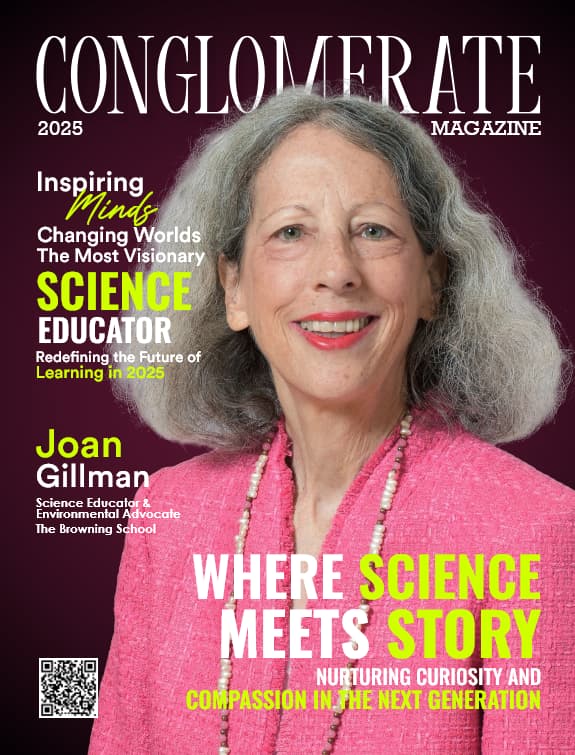In today’s rapidly evolving business landscape, few leaders have mastered the delicate art of balancing technological innovation with human connection quite like Larissa Murmann. As Digital CHRO at Unilever International, Murmann has pioneered an approach to human resources that transcends traditional boundaries—one that places artificial intelligence, emotional intelligence, and what she calls “subconscious intelligence” at the heart of organizational strategy. This month’s cover story explores how her unique global background shaped a visionary who is transforming HR in the digital age, and examines the philosophy behind her success in building high-performance, high-care, and highly digital cultures.
A Global Mindset Forged Through Cultural Immersion

Larissa Murmann’s journey begins in a way that perfectly prepared her for leadership in today’s interconnected world—with constant movement across continents. Her career has taken her through Singapore, Switzerland, the United States, Argentina, Spain, and Mexico, creating a foundation of adaptability that would later define her approach to HR leadership.
What some might view as a challenging lifestyle of perpetual change, Murmann embraces as an opportunity for growth. “When I landed in Singapore my mother asked me over a phone call: ‘How many times do you want to do this?’” Larissa recalls. “I asked her, ‘do what?’ She said: ‘Go through the hassle of changing countries, new friends, new company, new environment. Isn’t it tiring you?’ I had never seen it that way but rather as an opportunity of expanding my comfort zone.”
This perspective—that change represents growth rather than disruption—has informed every aspect of her professional approach. “Moving to a new country for me no longer is a hassle but now feels like a well-known skill,” she explains. This mindset has instilled in her a deep appreciation for diversity, recognizing firsthand how diverse perspectives lead to innovative solutions and drive organizational success.
For Larissa, HR was never merely about administrative functions. From her earliest professional endeavors, she viewed people management as a vehicle for creating inclusive cultures where everyone feels valued and heard. This philosophy eventually crystallized in her role at Unilever International, where as Digital CHRO, she has pioneered approaches to the people strategy that honor cultural diversity while driving sustainable business impact through technology.
Digital Transformation: A Journey from Fear to Passion
Murmann’s passion for AI, digital transformation, and the future of work wasn’t always self-evident. In fact, it was ignited relatively recently, in 2024, when her job title officially included “Digital.” This change necessitated a rapid acquisition of new skills and a reinvention of her professional identity—a challenge she embraced wholeheartedly.
A pivotal moment in this journey came when attending the Future Human Event hosted by Mindvalley. There, Murmann encountered an AI clone of herself—an experience she initially found intimidating. “The notion of an artificial intelligence replicating my role and skills was overwhelming,” she admits. “However, within just one day, my perspective shifted dramatically. I transitioned from fear to excitement, realizing the immense potential that digital innovation holds for HR.”
This transformative experience catalyzed a personal mission: to become the most Digital CHRO possible. Committed to continuous learning, she enrolled in the MIT AI Implications on Business Strategy course and the NUS Program for Chief Data, Analytics, and AI Officer—programs that equipped her with the knowledge and tools to harness AI effectively and strategically in the workplace.
Her perspective on AI reflects this journey from apprehension to advocacy: “I am deeply aware of the transformative power of AI. This knowledge fuels my responsibility, not only to myself but also to my team and the employees I business partner with. Helping them grow, especially in the era of AI, is crucial for securing livelihoods and staying competitive.”
This commitment to continuous learning has profoundly influenced her leadership style, instilling what she describes as a “strong growth mindset.” For Murmann, “Every situation presents two choices: to give up or to grow. I consistently choose growth because reinventing myself drives me.”
The Three Pillars of AI Integration to Organisations
Murmann’s approach to integrating AI into HR represents a departure from traditional implementation models. Where others might focus exclusively on efficiency or cost reduction, she has developed a framework that balances technological advancement with human needs across three key pillars:
- Workplace Efficiency: Tools like Microsoft Copilot simplify and streamline daily operations, allowing HR professionals to focus on more strategic initiatives rather than mundane tasks. “This efficiency is the foundation upon which further advancements can be built,” Murmann explains.
- Augmented Capabilities: AI tools significantly enhance existing processes, providing deeper insights and freeing up valuable time. “For instance, implementing an AI to augment our 360-degree feedback tools ensures comprehensive and less biased feedback, leading to more informed decision-making,” she notes.
- Differentiated Experiences: Innovative AI applications set organizations apart. “A prime example is the deployment of an AI clone for coaching newcomers during onboarding. This not only speeds up the onboarding process but also provides personalized support, a service that is currently unparalleled,” Murmann states. This innovation highlights how AI can deliver a differentiated experience that is both effective and unique.
This integrated approach has yielded tangible results. When Larissa initiated an AI integration project for her team, she ensured all team members obtained AI certification and instituted weekly one-hour digital upskilling sessions every Friday. During these meetings, the team explores new AI tools, shares insights, and discusses emerging trends, fostering a collaborative learning environment.
The team enlisted an AI coach to guide them through the integration process. The coach mapped current HR processes, identified AI opportunities, and provided invaluable insights for shaping their AI strategy. Each team member now explores and pilots one AI tool in collaboration with their IT partner, allowing them to experiment with various AI technologies, assess their potential, and refine their functionality.
“This initiative has been transformative, marked by learning, experimentation, and innovation,” Murmann explains. “As we continue embracing AI technologies, we look forward to unlocking new possibilities and driving sustained success in the digital age.”
Case Study: Building a High-Performance, High-Care, and Highly Digital Culture
The effectiveness of Murmann’s methodology is clearly demonstrated in her co-leadership of Unilever International’s Digital Transformation Strategy alongside the CTO. Recognizing the critical gap between technological advancements and user adoption—often arising due to lack of understanding, fear of change, and insufficient skills—she implemented several key strategies to build a high-performance, high-care, and highly digital culture.
“First, we recognize what drives and scares people,” Murmann explains. “Fear of obsolescence and the unknown can hinder adoption, but we counter this by highlighting the personal and professional growth opportunities that digital transformation offers.” This approach ensures that motivation is fueled by clear demonstrations of how new technologies can simplify workflows, enhance productivity, and lead to tangible career advancements.
The strategy emphasizes building skills through continuous learning and development, with digital coaching programs where leaders are paired with digital interns, promoting reverse mentoring. “This approach ensures that even senior leaders are constantly upskilled, and fresh perspectives are integrated into strategic decision-making,” she notes. Additionally, everyone in the organization is encouraged to apply for AI certifications, further enhancing collective digital expertise.
Leadership plays a vital role in creating this digital culture. Murmann has developed a cross-hierarchy digital champion network that includes everyone from the CTO to sales, marketing, supply chain, and finance leaders. This network ensures that digital initiatives are not siloed but are instead embraced across the organization.
To maintain momentum, the team regularly celebrates digital successes. “On a monthly basis we recognize publicly our Digital YODAs and show what they achieved,” Murmann shares. This practice ensures that the entire organization sees the benefits of digital transformation, reinforcing the value of embracing new technologies.
Navigating Complex Challenges in AI Implementation
Implementing AI in HR functions presents significant challenges that require thoughtful solutions. Murmann identifies several key hurdles organizations must overcome:
Data Management: HR departments must ensure that data is accurate, up-to-date, and compliant with privacy regulations, a particularly complex task when managing vast amounts of sensitive employee information.
Integration with Legacy Systems: Many organizations rely on existing HR technologies that may not seamlessly integrate with modern AI solutions. “To overcome this, organizations should adopt a phased approach, starting with integrating AI into less complex processes,” Murmann advises.
Leadership Skills Gap: Leading AI initiatives requires a nuanced understanding of both technology and human resources. “HR leaders must possess the skills to manage AI projects and lead teams effectively. Investing in training programs that enhance AI literacy among HR professionals is crucial,” she explains.
Fear of Replacement: A common concern among HR teams is the fear of being replaced by AI. “Organizations can address this by promoting the idea that AI is a tool to augment human capabilities rather than replace them,” Murmann suggests. Transparent communication about AI’s role, coupled with opportunities for upskilling, can alleviate these fears.
Resistance to Change: Overcoming natural resistance requires a comprehensive change management strategy. “Engaging employees early in the AI integration process and soliciting their feedback can foster a sense of ownership,” Murmann notes. Providing continuous support and training during the transition period helps employees adapt to new workflows.
Ethical Considerations: Organizations must ensure that AI decision-making processes are transparent, unbiased, and fair. “Establishing ethical guidelines, conducting regular audits, and having a diverse team to oversee AI applications can help address these concerns,” she explains.
Murmann’s approach to these challenges reflects her balanced perspective: “Our recruiting processes already have biases because they are managed by humans, and every human naturally has a bias. Hence we need to use AI to work more and more on eliminating biases and highlighting them rather than increasing them.”
The Future HR Leader: Three Essential Intelligences
As workplaces evolve at an unprecedented pace, Murmann believes every leader must develop three essential forms of intelligence to remain relevant and effective:
- Artificial Intelligence Literacy: “Understanding AI and leveraging its capabilities is fundamental,” Murmann asserts. “Leaders must be skilled in technology to help their teams stay ahead, optimizing processes and making informed decisions based on data analytics.” This knowledge enables leaders to harness AI’s full potential, driving innovation and efficiency within their organizations.
- Emotional Intelligence: While technological proficiency is crucial, emotional intelligence becomes even more important in leading through transformation. “Compassion, empathy, and the ability to understand and manage emotions will foster a supportive and collaborative environment,” Murmann explains. “Leaders with high emotional intelligence can inspire trust, motivate their teams, and navigate the complexities of change with resilience and grace.”
- Subconscious Intelligence: Perhaps most innovative is Murmann’s emphasis on what she calls “subconscious intelligence,” which she believes will play a vital role in maintaining sanity amidst accelerated change. “This involves tapping into our intuition and creativity, enabling leaders to make more holistic decisions,” she explains. “By cultivating subconscious intelligence, leaders can unlock innovative solutions and stay grounded, ensuring their well-being and that of their teams.” Cultivating the connection with yourself will be the most valuable relationship in an era of AI.
These three intelligences form the foundation of Highest Frequency, Murmann’s own company focused on helping organizations achieve rapid digital culture and leadership transformation. Through this venture, she helps leaders develop competencies across all three areas, preparing them for a future where traditional HR functions are increasingly automated.
“I am convinced that over the next decade, there will be two types of leaders: those that embrace AI and those that are out of business,” Murmann states firmly. “For me, embracing AI means having a clear vision of how to use it strategically within our organization.”
Creating a Legacy of Human-Centered Technology
Looking toward the future, Murmann envisions HR as a strategic business partner, leveraging AI to enhance rather than replace human capabilities. “Business and HR leaders must critically ask themselves: Do I want to focus on cutting cost and be responsible for firing more people, or do I want to be famous for upskilling my teams, growing my business, and securing livelihoods?” she challenges.
Her answer is unequivocal: “I choose the latter. To support this vision, I have decided to upskill myself to help our organization grow exponentially, augment the work of our teams, and prepare them for the future.”
This philosophy—that technology should serve human potential rather than diminish it—defines Murmann’s approach to HR leadership in the digital age. “The deep connection between an HR person and an employee driven by empathy is not something a machine can ever replace,” she reflects, “but machines can free up time for humans to connect more often.”
The legacy she aspires to leave behind is one of a transformative leader who championed the integration of AI to empower people rather than displace them. “I want to be remembered for creating a culture of continuous learning, where employees are equipped with the skills they need to succeed in an AI-enhanced world,” Murmann shares. “Ultimately, I hope to inspire future leaders to prioritize the human element in digital transformation, ensuring that technology serves as a catalyst for positive change and sustainable growth.”
Balancing Technology and Humanity: A Framework for the Future
As the business world continues to navigate the complexities of digital transformation, technological disruption, and workplace evolution, leaders would do well to consider Murmann’s central insight: lasting success comes not from choosing between human touch and technological efficiency, but from harmonizing both.
“The aim is not to choose between human or technology, but to harmonize both,” she emphasizes. “By integrating AI to augment and differentiate our team’s functions, we ensure that technology serves to enhance human capabilities, fostering a symbiotic relationship where human and machine work in harmony.”
In a world increasingly defined by automation and algorithms, Murmann’s approach offers a compelling alternative: HR as a bridge between technology and humanity, a catalyst for understanding, and a vehicle for positive organizational impact. Her story reminds us that true success isn’t measured in efficiency metrics or cost savings alone, but in lives transformed, potential unlocked, and organizations empowered to thrive in the digital age.
Taking Action: Embracing Digital HR Today
In today’s hyper-connected global economy, digital HR has become a business imperative. Organizations that fail to embrace this evolution face significant risks:
- Higher failure rates in talent acquisition and retention
- Greater difficulty adapting to rapidly changing workplace dynamics
- Missed opportunities to connect with an increasingly digital workforce
- Unpreparedness for the multilateral challenges of tomorrow’s business landscape
The leaders of tomorrow are those who act today—who recognize that digital transformation in HR isn’t an optional initiative but a fundamental driver of organizational success, employee engagement, and sustainable growth.
“Every situation presents two choices: to give up or to grow,” Murmann reminds us. “I consistently choose growth because reinventing myself drives me.”
The time for digital HR transformation is now. Join the movement.
Every situation presents two choices: to give up or to grow. I consistently choose growth because reinventing myself drives me







